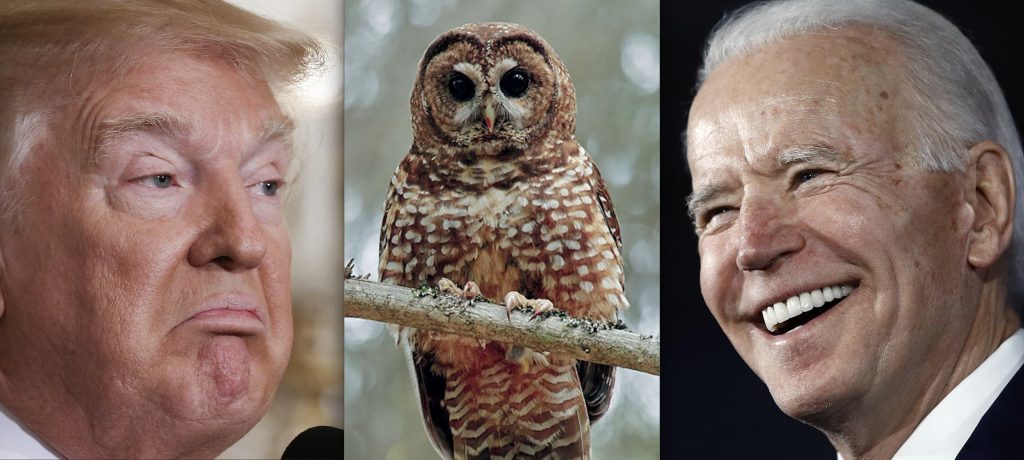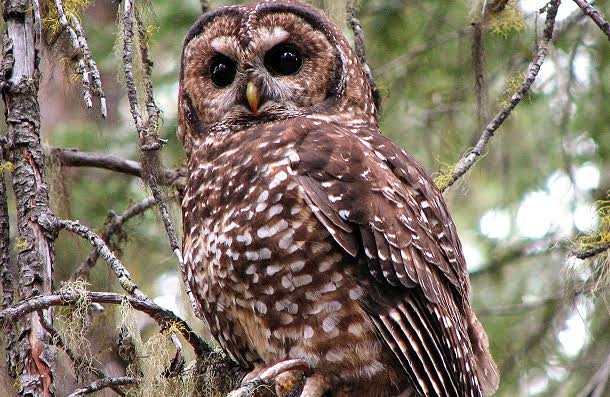Complete Reversal (Almost): Biden’s USFWS Rolling back Trump’s N. Spotted Owl Rule That Stripped 3.4M Acres of Habitat from the Bird

(EnviroNews Nature) — Washington, D.C. — In the last few months of Donald Trump’s term as president, his Interior Department (DOI) unfurled an unprecedented barrage of rule-changes and rollbacks targeting environmental regulations and wildlife protections; it took EnviroNews two in-depth reports spanning 7,000 words to catalog most of those rulemakings in bullet-point fashion — alterations that outraged America’s conservation movement across the board. Amidst the flurry of bad news for individual wildlife species, were several slashes to the Endangered Species Act (ESA/the Act) itself — cuts that removed or undermined key underpinning pillars of the Act — an overwhelmingly popular piece of bedrock legislation that garners around 80 percent support from the country’s citizens. The Act has saved 99 percent of the species listed under it from extinction.
One of those aforementioned cuts to the ESA created a loophole allowing economic considerations to be factored into the process of listing species — something expressly forbidden by Congress in 1982. Lawmakers got involved back then to strengthen the Act in an effort to prevent special interest meddling into the process; thereafter, listings were supposed to occur based only on the best available science and trade policy. But the Trump Administration steamrolled right over those guardrails and the northern spotted owl (Strix occidentalis caurina) became the first victim of the new loophole shortly thereafter.
ONE OF THE MOST POLITICALLY-FRAUGHT ANIMALS IN WORLD HISTORY
The northern spotted owl is an iconic aerial raptor, revered by many humans. But in the 1990s, it ended up smack-dab in the center of one of the most contentious environmental battles the country has ever seen. In 1991, a court order shut down logging in all Pacific Northwest old-growth forests harboring the bird, leaving loggers and sawmill owners furious. Slogans like Kill a Spotted Owl — Save a Logger and I Like Spotted Owls — Fried sprung up on signs and bumperstickers throughout the region.
The battle over owl habitat became so fierce in fact, that the ’91 court ruling even invoked an exemption from the “God Squad” — an almost-never assembled, powerful committee of seven presidential Cabinet members that can overrule the ESA. Finally, in 1994, Bill Clinton signed the controversial Northwest Forest Plan into law, widening the rift between loggers and conservationists even further.

The bird is currently managed under the ESA as a threatened species, but in December of 2020, the U.S. Fish and Wildlife Service (USFWS) — and ancillary agency of DOI — admitted the species is warranted for endangered status, but says it hasn’t been upgraded because of “higher priorities.”
As reported by EnviroNews, on Jan. 13, 2021, in the waning hours of Trump’s presidency, his DOI, under then-Secretary David Bernhardt, finalized a new rule for the spotted owl’s management plan. In one fell swoop, that amendment stripped the bird of approximately 3.4 million acres of habitat, from the Canadian border, deep into California. The move was referred to as “cruel” and “bewildering” by politicians and some of America’s leading wildlife conservationists.
At the time, Noah Greenwald, Endangered Species Director for the Center for Biological Diversity, said this in a press release:
Even in its final week, the Trump Administration is continuing its cruel, reckless attacks on wildlife at a breakneck pace. This revision guts protected habitat for the northern spotted owl by more than a third. It’s Trump’s latest parting gift to the timber industry and another blow to a species that needs all the protections it can get to fully recover.
ROLLING BACK THE ROLLBACKS
But only a week later, Joe Biden was sworn in as the 46th president of the United States, and with him, came a new Cabinet, including the first Native American Cabinet member ever: Secretary of the Interior Deb Haaland. Before being confirmed as Interior Secretary, in her short tenure in the House, Haaland gained a reputation for being a strong wildlife advocate. But even before Haaland could be confirmed on March 15, a chorus of Democratic lawmakers were already inserting themselves into the spotted owl issue, demanding that the Biden Administration reverse Trump’s controversial habitat exemption for the stealthy, ferocious flier.
On Feb. 2, 2021, eight Democratic lawmakers signed and delivered a letter, imploring Mark Lee Greenblatt, Inspector General of the Interior Department, to reverse Trump’s spotted owl rule. Senators Ron Wyden (D-OR), Jeff Merkley (D-OR), Dianne Feinstein (D-CA), Patty Murray (D-WA), and Maria Cantwell (D-WA), alongside Representatives Earl Blumenauer (D-OR), Raul Grijalva (D-AZ), and Jared Huffman (D-CA) were the signers. After laying out several grievances and accusing David Bernhardt of acting corruptly, the letter asked Greenblatt to “quickly review this decision [to] determine whether USFWS [under Trump] contradicted or ignored scientific recommendations made by career staff.” It would seem that call for action was heeded.
Congressman Jared Huffman Speaks to EnviroNews California: ‘The northern spotted owl is an indicator species for old-growth habitat that we haven’t protected very well’
On March 1, USFWS slammed the brakes on the Trump-Bernhardt rule, delaying its implementation and kicking the plan back into the environmental review process. Finally, on July 19, the Interior Department, under Deb Haaland, formally suggested a near-full reversal of the rule.

USFWS has also opened a 60-day public comment period, wherein members of the public can make their voices heard. Interested parties may submit comments electronically through the digital comment portal at this link: https://www.regulations.gov/document/FWS-R1-ES-2020-0050-0001. The agency wrote this atop its newly proposed rule which is now listed in the Federal Register:
We, the U.S. Fish and Wildlife Service (Service), propose to revise the designated critical habitat for the northern spotted owl (Strix occidentalis caurina) under the Endangered Species Act of 1973, as amended (Act). After a review of the best available scientific and commercial information, we propose to withdraw the January 15, 2021, final rule that would have excluded approximately 3.4 million acres of designated critical habitat for the northern spotted owl. Instead, we propose to revise the species’ designated critical habitat by excluding approximately 204,797 acres (82,879 hectares) in Benton, Clackamas, Coos, Curry, Douglas, Jackson, Josephine, Klamath, Lane, Lincoln, Multnomah, Polk, Tillamook, Washington, and Yamhill Counties, Oregon, under section 4(b)(2) of the Act as previously proposed.
While all this may seem like great news for the owl — potentially subtracting only 204,797 acres from its protected habitat instead of 3.4 million — conservationists like Greenwald — who’ve been spearheading the fight to protect the bird for years — say the owl should lose nothing. Greenwald said this in a press release:
We’re glad to see protections for the highly imperiled spotted owl restored, but all of this land should have been safeguarded. Since the owl was found to warrant endangered status in December, we would have liked to see no habitat exclusions. If we’re going to address both the extinction and climate crises, we must protect more forests from logging.
SO, WHERE SHOULD AMERICA GET ITS WOOD?
Greenwald makes the point that, according to the USFWS’ own research, the owl is actually under-listed as only threatened and hence, says none of its habitat should be whittled back at all. But the question remains: with America’s insatiable appetite for wood products, just where should the country harvest timber to fulfill its endless needs? To address that, we spoke with another long-time spotted owl conservationist: Steve Pedery, Conservation Director for non-profit Oregon Wild.
Pedery is a former Outreach Director for WaterWatch of Oregon and was also a communications specialist with the Sierra Club in Washington, D.C. He spoke with a group of reporters from EnviroNews Nature via email. That written interview reads as follows:
EnviroNews: Steve, we saw that the Center for Biological Diversity — one of the leading organizations fighting for the owl over the years — essentially said no spotted owl habitat should have been given up at all in the Biden Administration’s new plan. Would you say the new rule is a fair compromise though, or does Oregon Wild take the same stance on that?
Steve Pedery: I would say this is like discovering you have only overdrawn your checking account by $200,000, not $3.4 million. It’s good news, but only because the alternative was way worse. We have already lost 90 percent of our old-growth forests here in the Pacific Northwest, and the loss of even a single acre more is terrible.
EnviroNews: Are you concerned that if 200,000 acres out of 3.4 isn’t considered a fair compromise that industry and other critics will say: Well, you simply can’t negotiate with these environmental groups?
Pedery: Both the 200,000 and 3.4 million acre figures were born out of collusion between the Trump Administration and logging industry lobbyists, aimed at circumventing 30 years of environmental protection in the Pacific Northwest. The same mature and old-growth forests the northern spotted owl needs are also vital for clean drinking water, for salmon, and for capturing and storing carbon. The idea that there needs to be a compromise between one terrible, anti-environmental deal and another even worse one, is sort of like the guy who got caught stealing your car asking for you to compromise and let him drive it four days a week.
EnviroNews: Humanity will continue to have a need for timber and hence, logging. If the lost 200,000 acres aren’t a reasonable place to get timber from, where would be?
Pedery: There are tens of millions of acres of privately owned timber land all across the Pacific Northwest (and entire U.S.) that are now, and will continue to be, managed primarily for timber production. On top of that, there are millions of acres of previously logged stands on public Forest Service and Bureau of Land Management lands that provide poor habitat for the northern spotted owl and other old-growth dependent species, and would benefit from restoration-based thinning. There is absolutely no need to log mature and old-growth forests on publicly-owned lands in order to produce wood products. In fact, doing so constitutes a giant public subsidy for a handful of logging companies, creating an uneven playing field with private forest owners.
EnviroNews: Will Oregon Wild fight to recover the lost 200,000 acres, or will you cede that territory to DOI?
Pedery: Oregon Wild will continue to fight to protect and restore mature and old-growth forests, and to shift forest management towards more sustainable practices. Over the last 30 years this has really become a core public value in our region, and poll after poll has shown the public is on our side over this. Beyond that, and beyond the owl, the science is increasingly clear that these forests are also of enormous importance in the fight against climate change (Pacific Northwest temperate rainforest can store more carbon per acre than even the Amazon). Rather than continue to log these forests, we need to go in the other direction and manage our public lands to try and recover some of the 90 percent of old-growth that was lost to past clearcutting.
EnviroNews: 3.4 million acres seems like a lot of habitat set aside for one bird species. But what did the spotted owl’s historic territory look like? How much larger was it?
Pedery: To turn the question around, we’ve already logged 90 percent of the Pacific Northwest’s original old-growth forests. How much more do we need to clearcut? Prior to European invasion, the landscape of Western Oregon, Washington, and northwest California was dominated by old-growth forests. Estimates vary, but certainly tens of millions of acres. Today, about 90 percent of that original old-growth has been logged at least once.
The northern spotted owl has long been known as the proverbial canary in the coal mine for all the species of fish and wildlife that depend on these forests, from coho salmon (Oncorhynchus kisutch) and bull trout (Salvelinus confluentus) to marbled murrelet (Brachyramphus marmoratus) and pacific fishers (Pekania pennanti). Saving the owl’s habitat, and hopefully recovering some of what has been lost on public lands, benefits not just the bird, but everything else that depends on mature and old-growth forests. It also benefits human communities, as intact, older forests do a better job of maintaining cold, clean water in area rivers and streams, and are more resilient to threats like climate-driven forest fires. And the same old-growth the owls need are the most efficient system we have for capturing and storing carbon dioxide. The flip side is that logging these forests only benefits the handful of logging companies still tooled up to process these giant logs.
EnviroNews: Does Oregon Wild support methods like lethally removing the invasive barred owl (Strix varia) to help bolster northern spotted owl recovery?
Pedery: We believe the barred owl is a serious problem for recovering the northern spotted owl, and support taking steps to address that. However, it is important to remember that the root issue here is that the barred owl has moved in due to logging that has destroyed the mature and old-growth habitat that the northern spotted owl needs, and by heavily fragmenting what is left. It’s a real problem, but the barred owl should not be used as a distraction to divert attention from the destruction of old-growth habitat.
EnviroNews: Lastly, the spotted owl has been at the center of a ferocious battle between environmentalists and the logging industry for decades. Why is it so important to protect this particular species when so many are in peril?
Pedery: Northern spotted owls are what is known as an indicator species. Their health and population is a window into the overall health of all the other species that depend on mature and old-growth habitat. As the owl has declined, so have salmon, steelhead, and a myriad of other species. Because the owl is protected under the federal Endangered Species Act, it also drives policy debates over how this habitat should be managed in a way that [benefits] other species [that] do not have that strong legal protection.
The reason there have been battles over the owl for decades is that some logging interests have continually tried to undo those legal protections (as well as similar protections for salmon and other species). It’s not that different from the ongoing battles over offshore oil drilling, or weakening safeguards for clean drinking water (or at the international level, commercial whaling or clearcutting the Amazon).
Trump Tried to Rip off N. Spotted Owl of 3.4M Acres of Habitat; Rep. Huffman, Haaland, Dem Lawmakers Say No Way
(EnviroNews California) – Bon Tempe Dam, Marin County, California – At the end of former President Trump’s only term in office, his administration worked to dismantle the Endangered Species Act (ESA/the Act) on several fronts. One of those rollbacks changed the rules and allowed the U.S. Fish and Wildlife…
Did You Know There is a ‘God Squad’ That Can Overrule the ESA and Allow Any Species to Go Extinct? Rep. Jared Huffman Explains
(EnviroNews California) – Bon Tempe Dam, Marin County, California – What do snail darters, whooping cranes, and the iconic northern spotted owl have in common? They all had close calls with the so-called “God Squad.” The God Squad? The group’s existence and power even surprised EnviroNews Editor-in-Chief Emerson Urry when Representative Jared Huffman…
OTHER GREAT REPORTS FROM ENVIRONEWS ON SPOTTED OWLS
1st Species Screwed by Trump’s ESA Rollbacks: Iconic N. Spotted Owl, Robbed of 3.4M Acres of Habitat in OR/WA/CA
(EnviroNews Oregon) – Toward the end of Donald Trump’s first (and last) term, his administration made a handful of monumental slashes to the Endangered Species Act, removing several fundamental underpinnings of the 50-year-old, overwhelmingly popular, bedrock legislation. As reported by EnviroNews, one of those rollbacks allowed economic concerns from…
Biden Slams Brakes on Trump’s ‘Bewildering’ Rule That Stripped N. Spotted Owl of 3.4M Acres of Protected Habitat
(EnviroNews Nature) – Washington D.C. – As of March 1, 2021, the U.S. Fish and Wildlife Service (USFWS) is delaying the implementation of a final rule crafted at the end of Trump’s term until April 30, 2021. The rule-change, if it remains in place, will slash the northern spotted…
Rat Poison Killing Rare Northern Spotted Owls While the EPA, State Governments Do Nothing
(EnviroNews Nature) – The iconic northern spotted owl (Strix occidentalis caurina) is back in the news again as population numbers continue to decline throughout its range – from British Columbia to Northern California. The primary culprit in the story of this bird’s precipitous decline has always been recognized…
In Trump’s Waning Days, Mexican Owl Gains Victory in Rare Deal Between Environmental Org and U.S. Government
(EnviroNews Nature) – Amidst an unprecedented number of wildlife attacks and habitat rollbacks at the end of the Trump Administration, one critter won a rare victory. After a legal battle with the federal government that spanned the better part of a decade, environmental non-profit WildEarth Guardians (Guardians) announced it…
FILM AND ARTICLE CREDITS
- Emerson Urry - Journalist, Author



